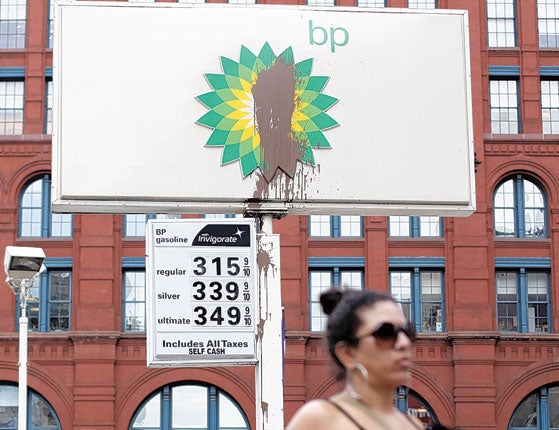As Obama flies in, BP finally has cause for hope
Submersible robots sever broken riser pipe - but agencies still cut firm's credit rating

Engineers with BP were preparing last night to place a new containment device over the crippled Gulf of Mexico oil well in advance of a third visit to the region this morning by President Barack Obama.
While the threat of failure remained high, the US Coast Guard reported that the company's fleet of robotic submersibles had succeeded in cutting off the broken and twisted riser pipe from the well after more than two days of trying. It cleared the way for the latest "top-hat" dome to be put in place. It is "a significant step forward", Admiral Thad Allen told reporters.
The crisis off the Louisiana coast continues to manifest itself on multiple fronts, from political to financial, and ecological. The National Centre for Atmospheric Research issued a warning that oil from the leak could float around the tip of Florida and show up on the US East Coast as far as North Carolina within weeks. Two leading Wall Street rating agencies downgraded BP, stating the growing risks of long-term damage to its reputation and its bottom line. Both Fitch Ratings and Moody's cited worries about growing liabilities for the company in likely clean-up and compensation costs. The White House said the US government was yesterday sending BP a $69 million bill for costs so far in its response to the spill.
For Mr Obama, the problem remains convincing a sceptical public that he has done enough to respond to the catastrophe. He is facing deep political peril from the ruptured well and the risks get higher with every day that passes without it being plugged. Analysts speculate that the spill could overwhelm his agenda in the crucial few months before mid-term elections, at a time when Democrats already face a big Republican comeback.
"We did respond aggressively," Carol Browner, the top energy aide to Mr Obama, said last night, but also admitted there were "things we should have done more quickly", at the start of the crisis in April. That included, she said, releasing Government estimates of the scale of the leak. Insinuating that the company may have downplayed the rate, she said: "BP has a financial interest in the flow-rate. They will pay a per-barrel, per-day fine."
Ominous comparisons continue to surface between Mr Obama's unexpected plight and the Iran hostage crisis that lasted 444 days. Mr Obama "will have to hope he doesn't end up as Jimmy Carter", wrote David Broder, the veteran commentator in The Washington Post. Mr Carter lost his 1980 re-election bid after being battered by his failure to resolve the hostage stand-off.
With the President coming and a conference call planned with analysts today, Anthony Hayward, BP's CEO, can only hope that the "top-hat" will work as planned. Last night he said it would be at least 24 hours before it was fitted and refused to accept suggestions that BP should not pay out $10bn in dividends due to investors shortly.
Hitherto every effort to stop the leak has failed. The "top-hat" should allow for the siphoning of at least some of the leaking oil and gas to a ship on the surface. But difficulties in making a clean cut when shearing off the riser pipe mean it is unlikely to fit tightly.
So far Louisiana has suffered the worst ecological damage since the 20 April blast on the Deepwater Horizon drilling rig that killed 11 workers. The slick has eclipsed the 1989 Exxon Valdez disaster as the worst oil spill in US history. The north-eastwards drift of the slick has put coastal residents in Alabama and Mississippi on red alert while the authorities in Pensacola have been warned to expect to see oil come ashore as early as this weekend.
"BP has ruined the island, our way of life, and our tranquillity," lamented Vickie Connolly, who owns a pub on Alabama's Dauphin Island that has seen tar balls and debris wash up.
Some experts had warned that cutting off the broken pipe could increase the rate of flow of oil from the well by as much as 20 per cent until the "top-hat" was firmly in place. Admiral Allen last night said it was too soon to know if that was happening. The Government thinks the well is spilling as many as 19,000 gallons every day.
US backlash: Tide of anger reaches forecourt
Americans fed up with BP and the response to the spill in the Gulf of Mexico are taking to the forecourt and to Facebook to let the company know their feelings.
The Reverend Jesse Jackson has been among those calling for a boycott of BP stations across the United States while as many as 300,000 people have joined a boycott-BP page on Facebook.
Also popular are T-shirts showing the petal-sunburst "Beyond Petroleum" logo of the company turning black.
A tide of disgust at the energy giant will serve further to damage its reputation but may have little direct impact on its bottom line, experts say. Revenue from petrol stations represents only a fraction of the company's earnings. Most of the garages are run by independent owners who may suffer more than the company.
"I would urge consumers to think about who actually gets hurt with their boycotts," said John Kleine, executive director of a trade group representing BP petrol station owners and operators who also depend on attached convenience shops. "Ultimately, small, local entrepreneurs and their families are the ones who get hurt, and not necessarily BP."
Join our commenting forum
Join thought-provoking conversations, follow other Independent readers and see their replies
Comments
Bookmark popover
Removed from bookmarks